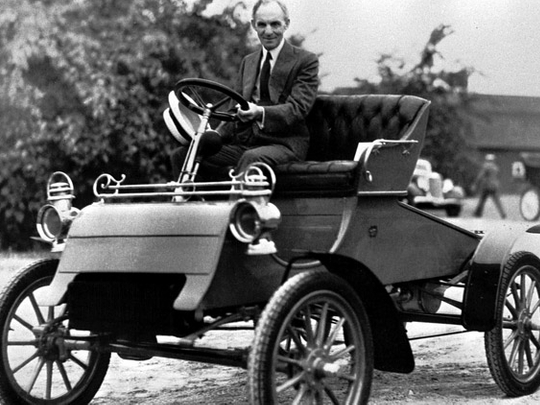
Henry Ford's fascination with machinery must have had quite a bit to do with where he was born — on his family's farm in Dearborn, Michigan, in 1863.
He developed a penchant for tinkering with machines as a youngster and enjoyed dismantling and then reassembling whatever he could lay his hands on — watches in particular — and became something of a repairman around the neighbourhood.
Having worked as an apprentice machinist in the city of Detroit, quietly experimenting on petrol-powered engines, he joined the Edison Illuminating Company in 1891, became chief engineer and created the Ford Quadricycle. It was equipped with a two cylinder engine, a buggy-type frame and had four bicycle tyres. The idea behind it was to generate an interest in the automobile and to create some much-needed capital to help him achieve his dream.
He founded the Detroit Automobile Company in 1899. It dissolved soon after, but not one to give up, he went on to form the Ford Motor Company in 1903 and promised to build "a car for the great magnitude." Five years later, he unveiled the Model T and it heralded the motor age. It was a simple-looking thing, the engine and transmission were enclosed, the four cylinders were cast in a solid block and the suspension used two semi-elliptic springs. It cost $850 (Dh3,120), was produced for 19 years and by the time the model run ended in 1928, 17 million had been sold. Detroit had become the auto-making capital of the United States.
The Model T evolved from what was first a luxury item for the rich, to an essential transportation device for the masses. By 1914, Ford had revolutionised the manufacturing industry and his Highland Park, Michigan plant, using a constantly moving assembly line was churning out complete chassis every 93 minutes while he paid his workers far above the average.
The Model T had a massive impact on American society. Since more and more people could own it, urbanisation patterns changed. More roads and highways were commissioned and people could now go anywhere, and at any time. It was hard to remember what life was like without a car. His mass production techniques meant a Model T rolled off the production line every 24 seconds. His franchise system enabled him to put a dealership in every city in North America, and in major cities all over the world. He became one of the richest men on the planet and was a household name.
His next move was to begin work in the industrial area on the Rouge River in Dearborn, Michigan. He oversaw production of a new plant and by 1927, it was ready to begin making Ford automobiles. However, once General Motors and Chrysler came into the picture, Ford began to suffer huge losses. The Model T was outdated, so a new Model A, along with a V8 engine, was produced.
The Thirties and Forties were tough times, and when his son Edsel, whom he had made president of the company, died in 1943, the elderly and ailing Ford took control again. But age and ill health forced him to hand the presidency over to his grandson Henry Ford II before he died in 1947.
He left a lasting legacy of hard work and perseverance and will always be remembered as one of the founders of the automobile industry.
Legends - leg·ends \'le-j nds\ -noun Myths, folklores, marvels and wonders of the most storied culture of all — car culture











